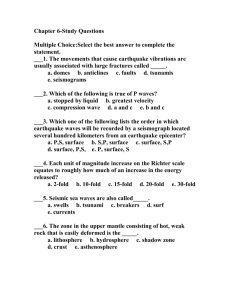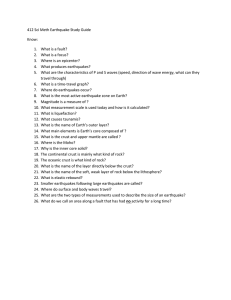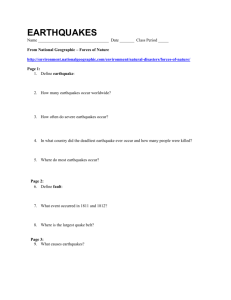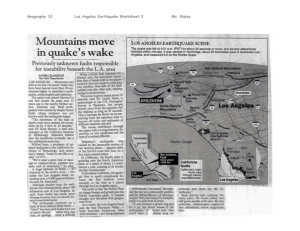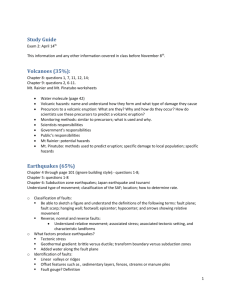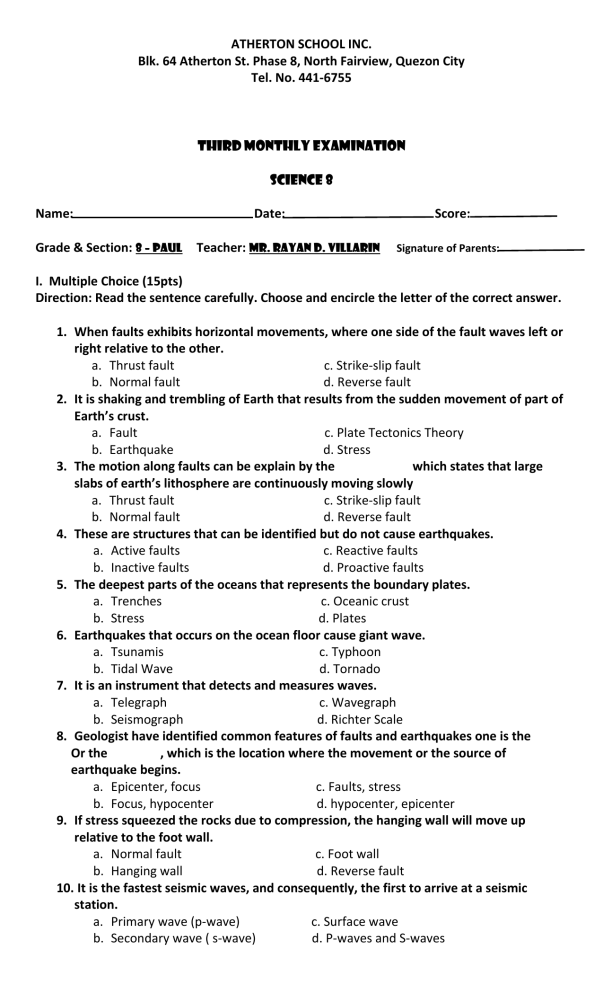
ATHERTON SCHOOL INC. Blk. 64 Atherton St. Phase 8, North Fairview, Quezon City Tel. No. 441-6755 Third Monthly Examination Science 8 Name: Grade & Section: 8 – Paul Date: Teacher: Mr. Rayan D. Villarin Score: Signature of Parents: I. Multiple Choice (15pts) Direction: Read the sentence carefully. Choose and encircle the letter of the correct answer. 1. When faults exhibits horizontal movements, where one side of the fault waves left or right relative to the other. a. Thrust fault c. Strike-slip fault b. Normal fault d. Reverse fault 2. It is shaking and trembling of Earth that results from the sudden movement of part of Earth’s crust. a. Fault c. Plate Tectonics Theory b. Earthquake d. Stress 3. The motion along faults can be explain by the which states that large slabs of earth’s lithosphere are continuously moving slowly a. Thrust fault c. Strike-slip fault b. Normal fault d. Reverse fault 4. These are structures that can be identified but do not cause earthquakes. a. Active faults c. Reactive faults b. Inactive faults d. Proactive faults 5. The deepest parts of the oceans that represents the boundary plates. a. Trenches c. Oceanic crust b. Stress d. Plates 6. Earthquakes that occurs on the ocean floor cause giant wave. a. Tsunamis c. Typhoon b. Tidal Wave d. Tornado 7. It is an instrument that detects and measures waves. a. Telegraph c. Wavegraph b. Seismograph d. Richter Scale 8. Geologist have identified common features of faults and earthquakes one is the Or the , which is the location where the movement or the source of earthquake begins. a. Epicenter, focus c. Faults, stress b. Focus, hypocenter d. hypocenter, epicenter 9. If stress squeezed the rocks due to compression, the hanging wall will move up relative to the foot wall. a. Normal fault c. Foot wall b. Hanging wall d. Reverse fault 10. It is the fastest seismic waves, and consequently, the first to arrive at a seismic station. a. Primary wave (p-wave) c. Surface wave b. Secondary wave ( s-wave) d. P-waves and S-waves 11. The formation of faults is generally caused by of rocks. a. Expansion c. Weathering b. Rolling d. Twisting or tearing apart 12. Earthquakes usually occur along a. Active faults c. Earth surface b. Between rocks layers d. Inactive faults 13. If an earthquake occurs and you are outdoors, the best thing to do is to a. Cover your head c. Run as fast as you can b. Seek a place to hide d. Stay in open areas away from buildings 14. The Philippines is prone to the constant tremors of the earthquakes because it a. Has many island b. Is at tropical zone c. Has plenty of mountain range d. Is located at the Pacific Ring of fire 15. The strength of an earthquake is measured according to the a. Seismograph c. Richter scale b. Seismogram d. Modified intensity Scale II. Identification A. Direction: Read the sentence carefully. Choose and identify the correct answer for each number below. Write your answer on the space provided. Earthquake Tsunami Fault Hanging wall Foot wall 1. 2. 3. 4. 5. secondary wave focus primary waves epicenter stress tidal wave active faults surface wave The movement or the source of earthquake begins. Giant waves caused by earthquakes that occurs on the ocean floor. A break or crack in the Earth crust. The point directly above the focus of an earthquake on Earth’s surface. A wave slower than a P-wave and can only move through solid rock, not through liquid or gases. 6. The shaking and trembling of earth as a result of the sudden movement of part if Earth’s crust. 7. The block of rock above the fault. 8. Also called hypocenter; the earthquake’s point of origin which is beneath the epicenter. 9. The fastest seismic wave that can move through solid rock and fluids. 10.The block below the fault. B. Direction: Direction: Read the sentence carefully. Choose and identify the correct effects of each Richter Magnitude. Write your answer on the space provided. Felt by some Damaging shocks Potentially perceptible Generally not felt-but recorded Potentially perceptible destructive in populous region major earthquakes, inflicts serious damage great earthquakes, destroy communities near epicenter felt by most Earthquake Magnitude and its Effects Richter Magnitude Effects Near Epicenter 2.0 and below 2.0 – 2.9 3.0 – 3.9 4.0 – 4.9 5.0 – 5.9 6.0 – 6.9 7.0 – 7.9 8.0 and above III. Enumeration Direction: Read the sentence carefully. Give or enumerate the correct answer for each number. 1-2 two types of Earth’s Crust 1. 2. 3-5 three mains of Seismic Waves 3. 4. 5. 6-10 Create measures on how you can help your community in the following events a) Before an Earthquake 6. 7. b) During an Earthquake 8. 9. c) After an Earthquake 10. IV. ESSAY (5pts) What other precautionary measures do you think the government should adopt to help the people prepare for earthquake?
